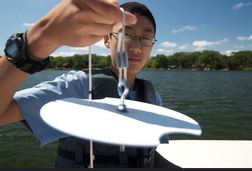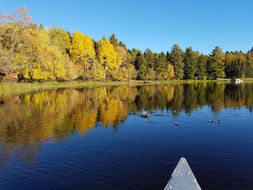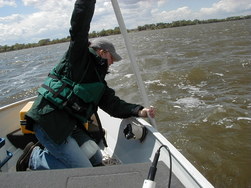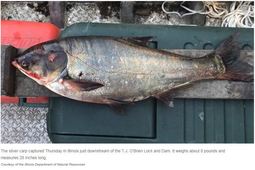 The monitoring season is winding down and there’s just a few
weeks left to take clarity readings on your lake or stream. After that, yet
another Secchi season comes to a close! The monitoring season always seems to
slip by so quickly!
As always, we are perennially thankful to all of you for your
dedication to lakes and streams in Minnesota. You are the eyes and ears on the ground,
monitoring our waterbodies. Your knowledge and engagement plays such an
important role in protecting lakes and streams and the MPCA is grateful for all
you do.
As a reminder, we prefer to receive all lake and stream Secchi
data by October 31st, if possible. This gives us the time needed to
enter it into our database and prepare it for display through our online reporting
system.
For many CSMP and CLMP volunteers, the most convenient way to
submit data is by using our electronic datasheet. The electronic datasheet is a
Microsoft Excel document that you must download to your computer. Simply fill
it in with your data, attach it to an email addressed to us, and you're done!
If you submit your data electronically, you can keep your paper datasheet for
your records. Important Note: DO NOT reply to this newsletter email with your 2016 Secchi data. The CMP DOES NOT receive any replies through the newsletter delivery system. Please send a separate email to us at the addresses listed below with your 2016 data.
You can download both the Lake and Stream Electronic
Datasheets from the My CMP
page on our website under the top heading “Data sheets”.
Please contact us if you have any trouble or questions at:
clmp.pca@state.mn.us with LAKE questions
csmp.pca@state.mn.us with STREAM questions
Volunteers who have requested paper communication will receive
a letter by the first week of October reminding them to submit data. All paper
datasheets can be submitted via mail to: Citizen Monitoring Programs, 520
Lafayette Rd N., Saint Paul, MN 5515. Back to Top
|

The second annual
Citizen Monitoring Program (CMP) Secchi Social is just a few weeks away on September 23rd at the Steele County Historical Society! Coffee and
sign-in starts at 9:00am. The program begins at 10:00am and runs through
3:00pm.
We have pulled
together an exciting group of speakers, food, and activities for you, and we
hope that you will join us for a fun day of sharing information, stories, and
getting to know one another! Here is a glimpse of what we have planned for the
day:
-
Rochester MPCA and local SWCD staff
will provide information on water quality monitoring and watershed work in the
region
- MPCA Environmental Outcomes
Division Director Shannon Lotthammer will provide details, and offer clarity,
on statewide water monitoring initiatives
- Citizen Monitoring Program
volunteers will share their thoughts & perspectives on their monitoring
experience
- Lunch speaker, Minnesota State
Climatologist Luigi Romolo, will talk about his work at the State Climatology
Office and his time as a CoCoRaHS coordinator in Louisiana
-
Roundtable discussions
and generation of ideas that will be submitted to Governor Dayton on how to
reach his “25 by 25” Water Quality Goal
- Special recognition of 5-year
“Milestone” volunteers in attendance
- Raffle prizes, including Fishing,
Camping, and Hiking Gift Packs, and 2 State Park Annual
passes
If you haven't already contacted us, please complete the online
RSVP form
by Friday, September 15th or
call Laurie at 651-757-2750 or Shannon at 651-757-2874 with your attendance information.
Due to space limitations, we can accept RSVPs for the first 140 guests. There
is no cost, and each volunteer can have one additional guest attend. PLEASE
NOTE: RSVP WILL CLOSE WHEN CAPACITY IS REACHED, OR ON SEPTEMBER
15TH. You only need to RSVP if you plan on attending.
If you are unable to join us this year, don’t worry, Secchi Socials will be
held annually at rotating locations around the state. Back to Top
|
What can biological communities tell us about stream health?

Did you know the fish and bugs, or biological communities, living
within Minnesota’s rivers and streams can tell a story about the quality of the
water and habitat within them? Each year the MPCA’s Biological Monitoring Unit
samples biological communities from approximately 200-400 selected sites located
on rivers, streams, and ditches throughout Minnesota. These waterways
range in size from a few feet wide to large mainstem waterways, such as the
Mississippi or Minnesota Rivers. So, how are the biological communities sampled,
and what can they tell us?
Fish are sampled once per site from June through
September, using electrofishing methods where an electric current is
placed into the water, temporarily stunning any fish within range of the
current. MPCA personnel use a net to collect the fish,
regardless of size, from the smallest minnows to the largest game fish, and
then place them into a tub of water. Fish are separated by species, and counted,
measured, weighed and released back into the stream. Depending on stream width
and depth, a variety of electrofishing methods are used to maximize sample
efficiency and quality. For small streams, a sampler walks through a stream
carrying a shocker wand and backpack that houses a battery. For large rivers,
boats are used that have the shocking equipment attached to the boat.
Bugs, or macroinvertebrates, are sampled once from August through
September at the same locations where fish are sampled. A specialized net is
used to take 20 individual samples from the most dominant habitat types: rocky
areas, instream vegetation, undercut banks, woody debris, and/or and piles of
leaves in the stream. The macroinvertebrates are placed in a jar with alcohol
to preserve the sample and brought to a laboratory for
identification.
Fish and macroinvertebrates are a great indicator of stream
health since some species are sensitive to disturbances. This allows biologists
to assess where potential issues may exist based on the communities present. For
example, some fish are very tolerant of low dissolved oxygen while others are
extremely sensitive to low dissolved oxygen levels. Looking at biological
samples, habitat assessments, and water chemistry samples can provide a good
picture of the stream health. Examples of potential problems may include low
dissolved oxygen, high sediment concentrations, agricultural or industrial
runoff, or lack of habitat. The information gathered can guide watershed
partners to restoration or protection efforts.
For additional information about biological monitoring
please contact Tony Dingmann at Anthony.dingmann@state.mn.us
or at 218-316-3914. In addition, please see the MPCA’s biological monitoring
webpage at https://www.pca.state.mn.us/water/biological-monitoring-water-minnesota#monitoring-18237558.
Back to top
|
 After years of research, data analysis, and consultation with tribes, and dozens of meetings and many hundreds of comments from stakeholders and concerned citizens, the MPCA has released its proposed changes to Minnesota rules that are meant to protect wild rice from certain types of pollution.
Wild rice is an important natural resource in Minnesota. It’s a cultural and spiritual resource to the Dakota and Ojibwe people and provides food for both humans and waterfowl. In 1973, Minnesota instituted a water quality standard to protect wild rice from elevated levels of sulfate, based on observations that wild rice grew in waters with lower sulfate levels, and didn’t in waters with elevated sulfate.
Today, the MPCA is proposing rule changes that take into account the newest evidence about how sulfate and sulfide affect wild rice. Read more
Back to Top
|
 The CMP's Citizen Science exhibit at the State Fair was a big success again this year thanks to all the lake & stream monitors who volunteered their time and shared their expertise with the public. 67% of all available shifts at the exhibit were filled by CMP volunteers - what a great turn out! Thanks again. The 2018 State Fair is less than a year away!
Back to top
|

A year ago, we put a call out for guest writers for this CMP newsletter and
we received a fantastic response. So much so, that the “Volunteer Reflections”
section of this newsletter has been filled with submissions for the last three
issues! We would like to thank everyone that shared their stories, perspectives
and writings with us. We really love this section of our newsletter and we hope
you do too!
Upcoming editions of Transparency Times now have space available for new
guest writers. We know many of you are involved in protecting and
serving our state's water resources more than just through the MPCA's Citizen
Lake and Stream Monitoring Programs. We know there are lake association board
members, county and city government employees, CLMP+ participants, fishing
guides, teachers and so much more. We are interested in hearing about
your work, your perspectives, lessons learned and best
practices, and we think other volunteers in the program would be interested
too.
Please consider being a guest writer on any of our upcoming program
newsletters. We generally have room for two stories per newsletter. If you have
an interest, please contact Shannon (shannon.martin@state.mn.us
, 651-757-2874) or Laurie (laurie.sovell@state.mn.us,
651-757-2750) with your proposed topic. Back to Top
|
 As the summer winds down and monitoring comes to a close, we are already thinking about producing the 2019 Citizen Monitoring Program Calendar! The CMP Calendar is a great way to highlight your favorite lake or stream, enjoy images from your fellow CMP volunteers, and spread the word about the great water quality work that you do. To make the 3rd annual CMP Calendar a reality, we need your most beautiful, high resolution water monitoring images captured across the seasons. Here are the types of images we are interested in featuring:
- A scenic vista of your stream or lake
- Pictures of wildlife that you encountered while monitoring
- An action shot of taking a Secchi transparency reading
- Images from all seasons: spring flowers, summer fun on the water, fall colors, snow & ice too!
Showcase your photograph in the 2019 CMP Calendar! Email your best images to: csmp.pca@state.mn.us (streams) or clmp.pca.state.mn.us (lakes)
Please note that it is critical to have images of high resolution (300 dpi or greater) so that they are good enough quality to print.
Thank you for helping to make the CMP Calendar a reality! Back to top
|


Monitoring water chemistry is an important component to understanding the
overall health of a lake. Collecting regular Secchi readings can serve as a
proxy for certain measurements such as phosphorus (nutrient) and chlorophyll-a
(algae), but occasional lab analysis of water samples is needed to get a true
picture of the condition of a lake. Testing for phosphorus and chlorophyll-a
can provide clues into the productivity of a lake (i.e. algal growth) and its
suitability for aquatic recreation.
For lakes lacking any past water chemistry data, establishing a baseline of
information is important. Generally, two years in a row of water chemistry monitoring
is sufficient to establish a baseline snapshot of lake conditions. Regular,
annual Secchi readings should follow (a minimum of twice a month, weekly if
possible). It is normal for Secchi results to vary a bit from year to year
based on weather conditions, particularly temperature and precipitation, but a
sustained changed in Secchi readings would indicate a need for a new round of
water chemistry testing. Aside from that, if Secchi readings remain consistent
year after year, a year of water chemistry testing would be advisable for a
lake approximately every five years. A lake’s response to changes in the
watershed is fairly slow, aside from large scale rain events or active
alteration of the landscape in immediate proximity to the lake, so testing more
frequently isn’t necessary to capture significant changes. Back to Top
|
 This past month, a live silver carp was caught 9 miles from Lake Michigan after eluding underwater electric barriers in its path. The fish was netted by a commercial fisher in the area and is the second Asian carp caught beyond the barriers since 2010. According to the Asian Carp Regional Coordinating Committee, there is no indication a breeding population exists beyond the barriers, but additional sampling of the area is planned. For more details, check out the "'Cause for Serious Concern': Invasive Carp Caught 9 Miles from Great Lakes" on NPR. Back to Top
|

 Identifying factors that harm fish and other stream life is a key part of the MPCA’s watershed approach to restoration and protection. Together with local partners, the MPCA examines several interrelated elements to identify these factors, or stressors, to stream health. The goal is to maintain conditions in healthy streams and fix problems in unhealthy streams. Some of the things examined during stressor identification studies include:
- Stream connections, such as dams, culverts and tile drainage
- Hydrology, including stream flow and runoff
- Water chemistry, including oxygen levels, nutrient levels and temperature
- Stream channel assessment, mainly erosion
To see if a stream stressor report is available for your area go to the MPCA watersheds map.
- Click on your watershed or type in your city
- Check “Watershed News” on the right
Back to top
|
 The MPCA uses similar monitoring, assessment, planning, and restoration processes to manage Minnesota's large rivers as those used for lakes and streams under its watershed approach. These five rivers — the Mississippi, Minnesota, Rainy, Red, and St. Croix — are important water resources for recreation, water supply, and for commerce.
The MPCA began monitoring large rivers in 2013, starting with the Mississippi river from its headwaters to the St. Anthony Falls. Monitoring of another large river began each subsequent year. The MPCA worked with border states to develop uniform monitoring and assessment processes for large rivers. The St. Croix River was monitored during 2017. Next year, monitoring will continue on the St. Croix River and crews will return to the Upper Mississippi River to begin a second cyle of large river monitoring.
Read more about the first large river monitoring report: Upper Mississippi River: What to protect, what to fix
Back to top
|

By CLMP Volunteer Cindy Valentine
We usually do our monitoring in the morning. The sun is out, the lake is not yet as busy
as it will be later in the day. We leave
Maxx in the cabin – our rescue cocker is not a fan of the boat. As we head down the hill, Michael reminds me
not to forget the boat key. Not an
impossibility – we do it fairly regularly, especially early in the season.
We head out to the deepest spot on the lake. We have a depth finder with a GPS, purchased,
in part to help us with monitoring; it also tells us the water and air
temperature and if needed, fish action around the boat. The truth is we know the lake so well that we
can locate the deepest spot from landmarks.
As it’s also one of the best fishing spots, following the boats is
another way to find it.
Our lake is small (373 acres) and the shore is fully built
up – mostly seasonal homes, with an increasing number of year-round places. The
lone business is a camp ground across the lake from our cabin.
Michael’s family has had a place on this lake since 1956. His father and grandfather built the original
cabin and last year we replaced it with a modern and winterized one of our
own. Michael doesn’t remember a time he
didn’t come to the lake; for me it was a package deal. I married him. I married his lake place.
We stop the motor and it’s time to drop anchor and get to
work. “Don’t forget to tie it to the
boat” he reminds me. I’ve already done
it and helpfully point out that the one time the anchor wasn’t tied up, he was
the one who didn’t do it on our neighbor’s pontoon much to the delight of
several members of the Lake Association Board.
But no matter, we’re ready.
My husband has the data sheet handily secured to a
clipboard. He’s the recorder. I prefer to staff the Secchi myself. We’ll record the time, water temperature and
air temperature, weather and lake activity.
Then it’s time to lower the Secchi. I take it out of the drawer and unwrap the
measuring tape. It’s quite a lot longer
than we need. At its deepest point, our
lake is 21 feet deep. The Secchi tape
goes maybe twice that depth. I make sure
I have the right glasses – regular, not sunglasses, to ensure optimal viewing.
I also carefully slip the safety wristlet over my hand. No need to lose the disk.
I drop it over the shaded side of the boat and watch
carefully as it falls. It disappears and
while continuing to look into the lake, I begin to raise the disk again. Now it comes back into view. I lower and raise the disk until I can
identify the midpoint. I call the
measurement out and we weigh anchor.
Before heading home, we make a short tour of the lake.
Michael and I have been monitoring Crow Wing Lake for three
years. I have been manning the Secchi
disk for exactly that long. It’s an
amazingly intuitive tool. I found it
easy to learn and use and also pretty accurate.
I like watching the visibility change over the season. The clarity in the spring that goes along
with the icy water that makes the splash when the disk goes in the lake bracing
and surprising. By summer, the sun is
warm and the soft splashes feel good. Alas,
the clarity is down and the lake is getting murkier. Fall clarifies the lake and begins the
cooling process. Another reminder of the
seasons on the lake.
We’re a good Secchi team, Michael and me. Our monitoring continues a data stream that
tells the story of our lake over the years.
We take it seriously and try to be consistent and accurate. Back to Top
|